Physical Address
304 North Cardinal St.
Dorchester Center, MA 02124
Massive irreparable rotator cuff tears are a difficult problem to treat. Previously described treatments such as debridement alone or in conjunction with partial repair with the goal of pain relief have been inconsistent at best and often do not address or improve functional deficiencies. The younger active patient population is often unwilling to accept the lifelong limitations imposed by reverse total shoulder arthroplasty. Thus, tendon transfer is the preferred treatment in this subset of patients with higher functional demands. Initially, the latissimus dorsi transfer was ubiquitously used to cover the defect and restore motion; however, more recent data have suggested that alternate transfers may be better suited to addressing the complex role of the rotator cuff in the multiplanar motions of the glenohumeral joint.
Although many transfers have been described, our preference is the lower trapezius (LT) transfer for posterosuperior rotator cuff tears and the latissimus dorsi (LD) to address anterior deficiency. The ipsilateral LT is harvested from the medial scapular spine, augmented with Achilles allograft, and inserted at the superior aspect of the infraspinatus footprint to restore external rotation (ER) and the posterior force couple of the rotator cuff. The anterior force couple is addressed with LD harvested from its humeral insertion and transferred to the superior aspect of the subscapularis footprint.
Physiologically young and active patient
History of irreparable rotator cuff tear, either anterior or posterosuperior
May have had previous attempted repair
Minimal antecedent shoulder pain suggestive of glenohumeral arthritis
Progressive pain, weakness, and limitation in shoulder motion
Desirous of both pain relief and improvement in shoulder function
Highly variable and specific findings dependent on location and degree of tear
Loss of active shoulder function in abduction, flexion, internal rotation (IR), and ER or findings of pseudoparalysis ( Fig. 37.1 )
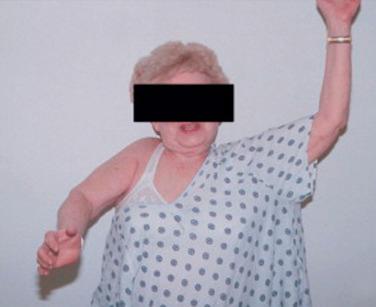
Posterosuperior tears have positive Jobe test result and show weakness in ER with ER lag.
Subscapularis tears demonstrate weakness of IR and increased passive ER with signs of anterior shoulder instability (such as positive apprehension test).
Belly press results tend to be equivocal in posterosuperior tears and positive in subscapularis tears.
Scapular dyskinesia can be seen; however, periscapular muscles must be normal to attempt LT or LD/teres major (TM) transfer ( Fig. 37.2 ).
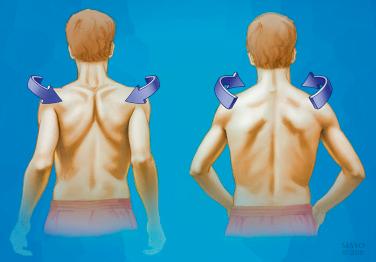
Plain films may demonstrate superior migration of the humeral head with a reduction of acromiohumeral distance, often less than 3 mm.
Anterior subluxation of the humerus on the glenoid may be seen in subscapularis tears.
Magnetic resonance imaging (MRI) shows massive rotator cuff tear involving either supraspinatus and infraspinatus, supraspinatus and subscapularis, or both with retraction of the torn tendons to the level of the glenoid.
Evidence of previous attempts at repair may be evident.
Fatty atrophy is typically seen, depending on the duration of the tear, Goutallier grades III–IV.
In posterosuperior tears, the infraspinatus fatty atrophy is often more advanced.
Minimal narrowing and changes of the glenohumeral articular cartilage may be seen on MRI scans, but evidence of osteoarthritis of this articulation should be absent on plain radiographs.
Nonoperative management with pain control, activity modifications.
Physical therapy is the mainstay of treatment with the goals of maintaining passive range of motion and strengthening of surrounding musculature. Antiinflammatory medications and/or injections are useful adjuncts for pain control and optimization of function. Despite conservative measures, tear progression, fatty infiltration, and progression of arthritis are to be expected.
Debridement.
May result in short-term pain relief; however, it has been shown that, especially in younger patients, symptoms may progressively worsen as a result of tear progression, superior migration of the humeral head, and progressive degeneration of the glenohumeral articular cartilage.
Partial rotator cuff repair.
The goal is to restore the anterior and posterior force couples and create an “anatomically deficient but biomechanically intact” construct. Although results of partial repair have been superior to debridement alone, progression of arthritis is frequently seen.
Reverse total shoulder arthroplasty.
For older patients with limited functional demands, this is a reliable operation for pain relief. However, this operation requires lifelong restrictions and involves the complications associated with arthroplasty, including lifelong infection risk, and is thus not commonly desired by a younger active patient.
Tendon transfer.
Numerous transfers have been described, including the pectoralis major or LD to restore IR and the LD, TM, or LT to restore ER. LD is the traditionally used transfer for posterosuperior tears, and sustained improvement in pain relief and motion have been demonstrated, though this has been less successful in more patients with underlying osteoarthritis, subscapularis insufficiency, or paralytic shoulders (<90 degrees of flexion preoperatively). LT has been shown to reliably increase ER and restore the posterior force couple in massive and paralytic shoulders. Likewise, LD transfer is ideal for restoration of the anterior force couple in irreparable subscapularis tears.
LT
Originates from the lumbothoracic spine and inserts on the medial aspect of the scapular spine ( Fig. 37.3 ).
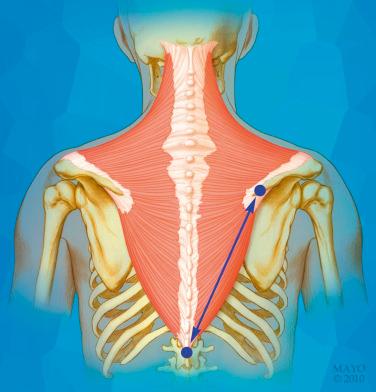
The spinal accessory nerve is consistently found 2 cm medial to the medial aspect of the scapula on the deep surface of the muscle ( Fig. 37.4 ).
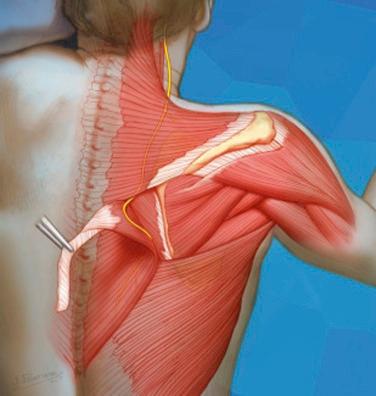
LD
Originates from the thoracolumbar fascia, iliac crest, inferior three ribs, and inferior angle of the scapula and inserts on the floor of the intertubercular groove of the humerus anterior to the TM ( Fig. 37.5 ) either independently or loosely bound or as a conjoint tendon ( Fig. 37.6 ).
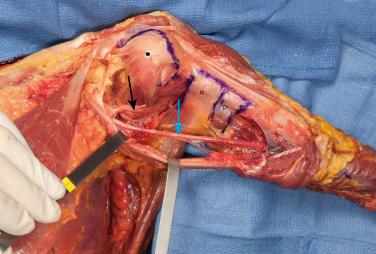
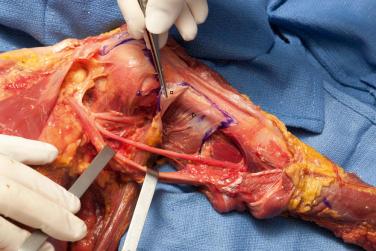
Axillary and radial nerves lie within 3 cm of the insertion site of the LD ( Fig. 37.7 ), though these distances are dependent on arm position and may be less than 2 cm.
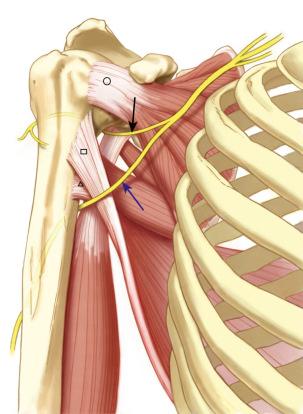
TM
Originates from the inferior angle of the scapula and inserts on the medial lip of the intertubercular groove slightly posterior and distal to the LD, with similar relationships to surrounding neurovascular structures at its insertion
Supraspinatus, infraspinatus, and subscapularis footprints
Symptomatic, irreparable rotator cuff as determined by grade III/IV fatty atrophy, extent, and retraction of tear and/or failed previous attempt at repair
Posterosuperior tear addressed with LT transfer to superior aspect of the infraspinatus footprint
Intact or reparable subscapularis necessary for isolated LT transfer
Anterior tear addressed with LD or combined LD/TM transfer to the subscapularis footprint
Can be done in conjunction with the LT transfer
Minimal glenohumeral arthritis
Those with advanced degenerative disease may be more appropriate candidates for arthroplasty.
Patients younger than 55–60 years old with high functional demands
Patients older than 55–60 years old unwilling to undergo reverse total shoulder arthroplasty
Adequate periscapular muscles available for transfer
At least grade IV strength
Lateral decubitus position is standard for open procedure.
Operative side up, prepped from midline posteriorly to midline anteriorly
For arthroscopically assisted transfer, beach chair position is preferred with the use of a pneumatic arm holder (Spider 2; Smith & Nephew, Andover, MA). This can also be performed in a lateral decubitus position ( Fig. 37.8 ).
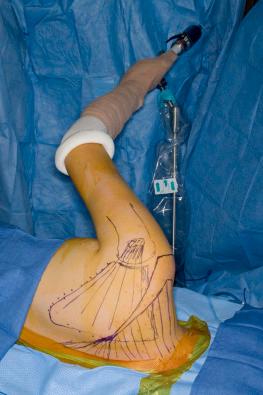
Well-padded bony prominences.
Wide preparation will allow easy access to the medial aspect of the scapular spine.
An open-backed chair with McConnell head holder may be helpful if performing arthroscopically assisted procedure with the patient in a beach chair position ( Fig. 37.9 ).
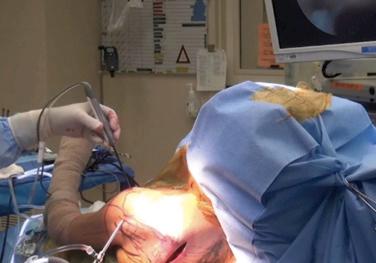
Extra preparation in the axilla to minimize risk of infection.
The most common and significant pitfall is inadequate draping posteriorly.
Pneumatic arm holder (Spider 2; Smith & Nephew, Andover, MA)
Open-backed chair with McConnell head holder for arthroscopically assisted procedure
Small saw for acromion osteotomy, possible clavicular or medial scapular spine resection
High-speed burr for preparation of the insertion sites
Small osteotomes for harvest to allow bone-to-bone healing at transfer site
TenoGlide (Integra Life Sciences, Plainsboro, NJ) for wrapping the tendon to prevent adhesions
A nerve stimulator may be helpful intraoperatively.
Become a Clinical Tree membership for Full access and enjoy Unlimited articles
If you are a member. Log in here